https://www.freepressjournal.in/analysis/judiciary-is-india-a-democracy
Judiciary V: Without good justice delivery and education democracy is just not posible
(All other articles in the Judiciary series can be found at http://www.asiaconverge.com/2021/03/the-judiciary-series/)
RN Bhaskar 25 March 2021
S. Jaisankar, India’s minister for external affairs, is not one who is associated with harsh words. Yet last week, he was fulminating against two international reports which criticised the freedom and democracy in India (https://www.freepressjournal.in/analysis/fpj-edit-foreign-minister-s-jaishankar-ko-gussa-kyon-aata-hai). He charged them with them “Hypocrisy” and said that they were acting like “self-appointed custodians of the world who find it exceedingly difficult to stomach that somebody in India is not looking for their approval”.
His ire was directed against two reports. One was by the US-based human rights watchdog Freedom House which downgraded India’s status from ‘free’ to ‘partly free’ and accused the Prime Minister Narendra Modi-led central government of “driving India toward authoritarianism”. The second was the Sweden-based V-Dem Institute. It said India is no longer an “electoral 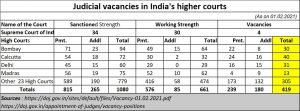 democracy” and is now an “electoral autocracy”. It added that a serious decline in democratic freedoms occurred after the BJP’s 2014 Lok Sabha polls victory.
democracy” and is now an “electoral autocracy”. It added that a serious decline in democratic freedoms occurred after the BJP’s 2014 Lok Sabha polls victory.
The rule of law
He said that there were things wrong with those countries as well. He may be right. No country is perfect. But a mistake is different from continued defiance of what is right. For instance, the judicial mess, which requires helpless people to wait for years to get justice. Or when successive governments make laws to destroy well established laws (http://www.asiaconverge.com/2021/03/jjudicial-and-the-extra-judicial-will-there-be-a-face-off/ ).
The other countries that he refers to do not have judicial vacancies that continue to gape indecently at believers in democracy. These countries may have a one-off police killing (George Floyd which resulted in the Black Lives Matter movement). Rape is a rare crime, not an everyday occurrence, and certainly not where shelters for abandoned girls’ are used as a source for paedophilia (http://www.asiaconverge.com/2020/09/india-plundered-again-by-tweaking-rules-against-prosperous-states-and-encouraging-profloigacy-irresponsibility/). A vibrant democracy knows how to control such events.
In India, for historical reasons, as well as the myopia of policymakers, democracy has remained an imperfect one. For instance, the courts refuse to hear a case filed decades ago by the Swatantra Party’s Sharad Joshi (https://www.freepressjournal.in/analysis/the-farmer-who-cried-for-economic-freedom). His question was how could India allow past prime minister Indira Gandhi to introduce the term socialist and secular in the preamble to the Constitution (see Item 2 at https://www.india.gov.in/my-government/constitution-india/amendments/constitution-india-forty-second-amendment-act-1976). The Preamble to the Indian Constitution originally read “a “sovereign democratic republic”. The words socialist and secular were added to the Preamble through an amendment.
He rightly pointed out that if India is a democracy, people should be allowed to choose between a capitalist or a socialist model. He also objected to the introduction of the word secular in the Preamble by the then government. He believed that the amendments flew in the face of democracy as a concept.
It is one of the many sensitive cases, the Supreme Court has refused to deal with. Another instance is the one where the government in March 2018 amended the Foreign Currency Regulations Act (FCRA), which allows political parties to get funds from overseas with no questions asked, and that too with retrospective effect for 42 years — http://www.asiaconverge.com/2018/03/corruption-collusion-legislative-filibustering/. You cannot have one law for NGOs and another for political parties. Both cases are hot potatoes for the jurists.
Of course, one particularly good excuse the courts have is that the backlog of cases is way too large, and some cases will always get delayed. But the principal cause for the backlog of cases is that at least 25-40 percent of judicial posts are vacant. The first chart only talks about vacancies at the Supreme Court and the High Court.
However, as another chart shows, such vacancies exist in lower courts as well, in consumer courts and even CBI courts (http://www.asiaconverge.com/2021/02/judiciarys-fabric-frayed-thanks-primarily-government/).
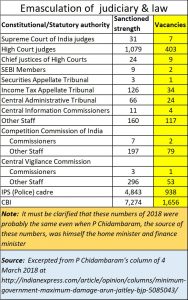 When there are vacancies only at one level of the judiciary, that could be (reluctantly) accepted as oversight. But when such vacancies exist at all levels, there is clearly mischief at work. That this has continued with government after government, especially after the 1970s, is a good indication that the legislators and bureaucrats are just not comfortable with the concept of democracy.
When there are vacancies only at one level of the judiciary, that could be (reluctantly) accepted as oversight. But when such vacancies exist at all levels, there is clearly mischief at work. That this has continued with government after government, especially after the 1970s, is a good indication that the legislators and bureaucrats are just not comfortable with the concept of democracy.
Education mauled
But what actually makes the picture worse are (deliberate) shortages on other fronts as well. This is most acutely visible on the education front. Just look at the vacancies that exist in the field of higher education alone. Even premier institutions like the IITs and the IIMs have not been spared. And these are teaching posts.
Democracy survives only when there is effective justice. The speed at which the wheels of justice move, is one key indicator about how good the judicial system is. India comes out quite poorly on this score.
So, with few teachers even in the face of the extremely poor number of sanctioned posts – with the threat of reservation of teaching posts always a sore point with educationists – the situation becomes that much more pathetic. And when merit is thrown to the winds and reservation of teaching posts encouraged, you subject an entire generation of students to despise people who did not deserve to hold such teaching posts. This too leads to the corrosion of democratic values and traditions.
Finally, the absurd ways in which teaching norms are ignored, which could lead to the devaluation and degradation in the standards of education, makes the future of education nightmarish. A good instance is the way the government wants to allow students into engineering without doing their maths or science (https://indianexpress.com/article/education/aicte-new-rules-maths-physics-7234939/).
Three legs for governance
Two of the basic requirements for any governance model (not just a democracy) to function are a good 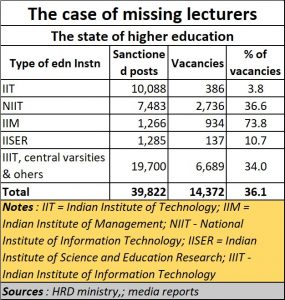 and effective judicial system, and good education. A third leg is healthcare. But medical education also gets covered indirectly under the umbrella of education. Without education, the state cannot upgrade its most important resource, its people.
and effective judicial system, and good education. A third leg is healthcare. But medical education also gets covered indirectly under the umbrella of education. Without education, the state cannot upgrade its most important resource, its people.
Without these, people cannot lift themselves economically. So poverty, lack of education and terrible justice delivery create a perfect breeding ground for a mafia.
A government which woos the people for voting it to power, and later cares two hoots about upgrading the quality of education or justice is one that economy watchers should be careful about. It is a government that will actually encourage the promotion of rent-a-mob crowds.
Without good education, there cannot be good jobs, equality (because the poor will always remain at the bottom of the economic pyramid), or a confidence in the future. Without them, the inclination to use violence or extra-judicial methods to get justice done will become immensely appealing. In the Hyderabad rape case, the public cheered when the police shot dead four suspected rapists. This is not a sign of democracy (or good governance) either.
The rising impatience with the lack of employment opportunities also makes the clamour for for reservation of jobs seductive. Had there been good education, the need for job reservations should not have arisen. A democracy requires all people to be equal, and hence provides special incentives to allow the weak to climb. Education should be the means to enable people to climb, not reservation of jobs.
Education degraded
Take a closer look at education. Go to the website of the ministry of human resources development. Look for data on teacher vacancies (https://www.education.gov.in/sites/upload_files/mhrd/files/statistics-new/ESAG-2018.pdf). The latest 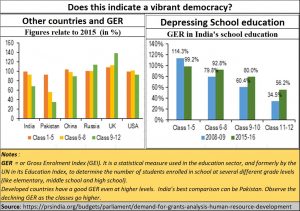 report is for 2018, not 2020. And the data in that report dates back to 2012-2016. This is also an implicit admission by the current government that it still replies on data that the previous government compiled and made available to the public.
report is for 2018, not 2020. And the data in that report dates back to 2012-2016. This is also an implicit admission by the current government that it still replies on data that the previous government compiled and made available to the public.
One more indicator to show that democracy is failing in India. Without information, there can be no meaningful discussion, and no bright solutions on how to deal with crisis. All you get then are government versions, not actual data. That is one of the key reasons why the farmer agitation has become so filled with rancour and distrust (https://www.moneylife.in/article/the-fight-is-no-longer-between-the-good-and-the-bad-but-between-the-corrupt-and-the-rapacious/62370.html)
But scrounge around for data, and you can get some of it from the website of PRS Legislative Research, a non-governmental body. It has played a stellar role in providing information of matters that should concern citizens (https://prsindia.org/budgets/parliament/demand-for-grants-analysis-human-resource-development).
The data tells you that unlike developed countries – where the GER (Gross Enrolment Ratio) climbs as the educational levels increase, in India it declines with each advancing level of education. The charts tell you that the only country with which India can now compare itself with is Pakistan, not the developed nations. And this is after paying lip service to Atma Nirbhar Bharat (a self-reliant India) and Sabka Saath, Sabka Vikas (loosely translated as With Cooperation we shall see development). Without a good judicial system, and without education, the spiel of self-reliance, cooperation and development turn out to be chimeras –mere slogans to make people forget the mockery that is being made of democracy and the economy.
Even the much-touted New Education Policy becomes a joke (http://www.asiaconverge.com/2020/08/the-national-education-policy-has-little-vision-less-strategy/).
Look at some other snippets that one picks up from media, but not from the government (though technically, the government is the primary source). In September 2016, media reports talk about there being over five lakh posts of primary teachers lying vacant in government schools across the country (https://indianexpress.com/article/education/over-5-lakh-vacant-primary-teacher-posts-hrd-ministry-to-write-to-state/).
Then take another snippet which states that as of 2020 there are there were 61.8 lakh sanctioned posts in government schools in the country of which 10.6 lakh posts lie vacant (https://timesofindia.indiatimes.com/india/17-of-teaching-posts-in-govt-schools-vacant/articleshow/78212162.cms).
And there are educational websites which underscore how the burden for teachers has increased during the past five years. By 2015 there were 22 students on one teacher; by 2019, it had risen to 29 (https://www.techforftcp.com/2020/09/india-teacher-population-ratio-update-how-many-teacher-are-in-india-all-you-need-to-know-what-is-the-total-number-of-male-female-shiksha-in-india-today-gender-gap-in-teaching-in-primary-schools.html).
None of this finds any mention on the government website for the Ministry of Human Resource and Development. So, the government first fails in providing good education, then ensures that the Indian public is not educated about this fact. Ditto for all the answers that are given in the Lok Sabha and the Rajya Sabha. Even access to such information has been made difficult.
No wonder then India has a large number of students who perform disastrously at almost every competitive score compared to their counterparts elsewhere in the world (http://www.asiaconverge.com/2021/02/budget-2021-weakens-india-not-strengthens-it/).
A prayer for the future
Even the latest budget provides little money for education and health. To cover up its failures on the health front, it now wants ayurveds and homeopaths to become allopaths (regular doctors) by passing a “bridge course”. This has been challenged in the courts. It now wants to allow Ayurveda doctors to perform operations in regular hospitals. This decision has been challenged by the Indian Medical Association (IMA) and the Supreme Court has served a notice on the government to explain its stand (https://www.freepressjournal.in/india/surgeries-by-ayurvedic-medics-will-create-havoc-supreme-court-seeks-centres-reply).
The inability to fill up judicial vacancies, the failure in filling up teacher vacancies, the threat of introducing reservations even in institutes of higher learning, and the corrosion of education at the very foundation of education in schools together reinforce the belief that democracy is truly under threat.
Yes, there is no denying that India is still a democracy. This column could not have been written if there were no freedom of speech. But the space for freedom is rapidly shrinking – as the resignation of Pratap Bhanu Mehta from the prestigious Ashoka University shows (https://indianexpress.com/article/india/pratap-bhanu-mehta-resignation-letter-ashoka-university-7234669/).
That is why this judiciary series of articles becomes relevant. It is a fervent plea to policy influencers to restore to India the pride and prosperity it deserves, and to stop squandering this nation’s wealth of vote banks (http://www.asiaconverge.com/2020/09/the-plunder-series/). It is never too late to restore the rule of law, a sense of dignity, and faith in the future. A strong judiciary is the starting point. The way the judiciary is sought to be weakened is alarming.
None of this bodes well for either improving the prosperity of people, or for democracy. Instead, there is a lurking fear, as explained in a previous column (http://www.asiaconverge.com/2021/03/judiciary-3-india-forgets-the-spirit-behind-the-rule-of-law-makes-a-mockery-of-justice/) that vigilantes, sponsored by the state, will increasingly be given more leeway to settle issues which the government does not like.
True, the judiciary will also have to work on ways to week out corruption, to be more transparent in the way it appoints judges – there should be an open discussion on the Judicial Commission. But first fill up the vacancies. Reduce the pendency in courts. And then begin discussions. You cannot expect discussions to be fair when one player has his eyes blindfolded, or his hands tied behind his back.
Will India redress this? Will saner councils prevail? That is a prayer on the lips of every Indian o cares for the future.









































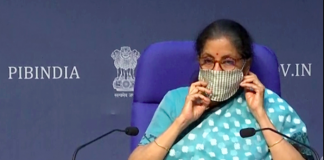
COMMENTS